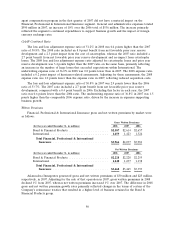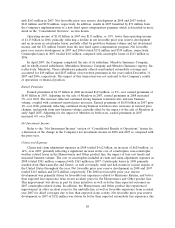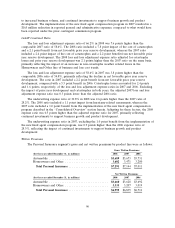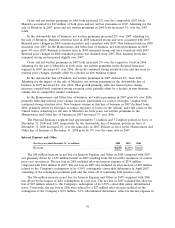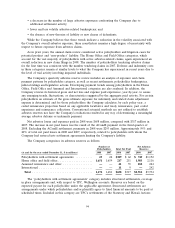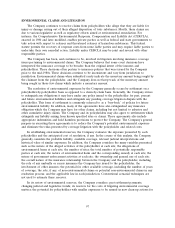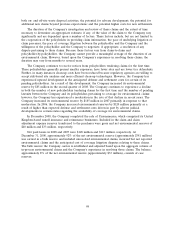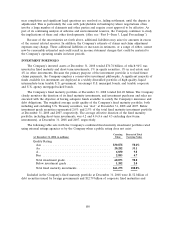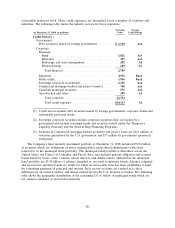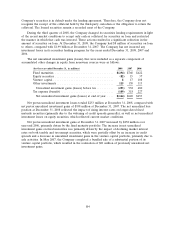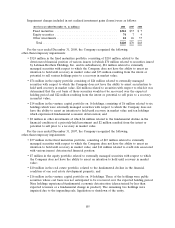Travelers 2008 Annual Report Download - page 107
Download and view the complete annual report
Please find page 107 of the 2008 Travelers annual report below. You can navigate through the pages in the report by either clicking on the pages listed below, or by using the keyword search tool below to find specific information within the annual report.and the Common Law Claims (collectively the Direct Action Settlement). As stated above unless the
Second Circuit’s decision vacating the approval of the settlement is reversed and the bankruptcy court’s
order approving the settlement is reinstated and becomes final, the Direct Action Settlement will be
voided and TPC will have no obligation to pay the amounts under the Direct Action Settlement (other
than certain administrative expenses). In that event, the reserves assigned to the settlement will be
returned to TPC’s unallocated asbestos reserve. (For a description of these matters, see ‘‘Item 3—Legal
Proceedings’’). Coverage in place arrangements represent agreements with major policyholders on
specified amounts of coverage to be provided. Payment obligations may be subject to annual maximums
and are only made when valid claims are presented. Wellington accounts refer to the 35 defendants
that are parties to a 1985 agreement settling certain disputes concerning insurance coverage for their
asbestos claims. Many of the aspects of the Wellington agreement are similar to those of coverage in
place arrangements in which the parties have agreed on specific amounts of coverage and the terms
under which the coverage can be accessed.
The ‘‘home office and field office’’ category relates to all other policyholders and also includes
unallocated IBNR reserves. Policyholders are identified for home office review based upon, among
other factors: a combination of past payments and current case reserves in excess of a specified
threshold (currently $100,000), perceived level of exposure, number of reported claims, products/
completed operations and potential ‘‘non-product’’ exposures, size of policyholder and geographic
distribution of products or services sold by the policyholder. In addition to IBNR amounts contained in
the reserves for home office and field office policyholders and the costs of litigating asbestos coverage
matters, the Company has established a reserve for further adverse development related to existing
policyholders, new claims from policyholders reporting claims for the first time and policyholders for
which there is, or may be, litigation and direct actions against the Company.
On January 29, 2009, the Company and PPG Industries, Inc (‘‘PPG’’), along with approximately 30
other insurers of PPG, agreed in principle on a modified settlement agreement to settle asbestos-
related coverage litigation under insurance policies issued to PPG. The tentative settlement agreement
has been incorporated into the Modified Third Amended Plan of Reorganization (‘‘Amended Plan’’)
proposed as part of the Pittsburgh Corning Corp. (‘‘PCC’’, which is 50% owned by PPG) bankruptcy
proceeding. Pursuant to the proposed Amended Plan, which was filed on January 30, 2009, PCC, along
with enumerated other companies (including PPG as well as the Company as a participating insurer),
are to receive protections afforded by Section 524(g) of the Bankruptcy Code from certain asbestos-
related bodily injury claims. The Company had entered into a prior agreement in principle with PPG in
2002 which was contingent upon final court approval of the Second Amended Plan of Reorganization
for PCC, but in December 2006, the United States Bankruptcy Court declined to confirm that Plan of
Reorganization. As a result of the December 2006 ruling, the Company removed the reserves
associated with the prior agreement from the structured settlement category of the asbestos reserve and
made a corresponding increase in the unallocated asbestos IBNR reserve. Under the current agreement
in principle, the Company has the option to make a series of payments over the next 20 years totaling
approximately $620 million to the Trust to be created under the Amended Plan, or it may elect to
make a one-time discounted payment, which, as of June 30, 2009, would total approximately
$430 million (approximately $400 million after reinsurance). The current agreement in principle with
PPG is subject to numerous contingencies, including final court approval of the Amended Plan, and the
Company has no obligation to make the settlement payment until all contingencies are satisfied. The
Company’s obligations under this agreement in principle continue to be included in the unallocated
asbestos IBNR reserve.
Assumed reinsurance exposure primarily consists of reinsurance of excess coverage, including
various pool participations. Prior to the sale of Unionamerica in December 2008, International was
exposed to U.S. asbestos liabilities through participations in excess insurance policies, quota share and
excess of loss reinsurance policies, and retrocession policies, underwritten in the London insurance
95



